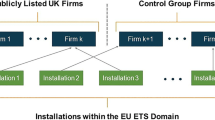Abstract
Tradable environmental rights are increasingly pursed as a regulatory instrument, to control for environmental quality. However, in the presence of market power, regulation through an allocation of tradable rights generally yield inefficient outcomes. This article analyzes the effect of the initial distribution of tradable rights on the firms’ strategies and performance in abatement and production, and proposes an efficient criterion for the allocation of tradable rights among firms with market power and competitive fringe firms. The suggested criterion maximizes efficiency of the market based regulation. A simple numerical example illustrates the theoretical discussion.
Similar content being viewed by others
References
S. Borenstein J. B. Bushnell F. A. Wolak (2002) ArticleTitle“Measuring Market Inefficiencies in California’s Restructured Wholesale electricity Market” The American Economic Review 92 IssueID5 1376–1405 Occurrence Handle10.1257/000282802762024557
J. K. Brueckner (2002) ArticleTitle“Airport Congestion When Carriers have Market Power” The American Economic Review 92 IssueID5 1357–1375 Occurrence Handle10.1257/000282802762024548
R. H. Coase (1960) ArticleTitle“The Problem of Social Cost” Journal of Law and Economics III 1–44 Occurrence Handle10.1086/466560
D. M. D. Eshel (2004) The Economics of the Allocation of Tradable Pollution Rights University of California Davis California
Fershtman, C., and A. de Zeeuw. 1995. “Tradable Emission Permits in Oligopoly.” Tilburg Center for Economic Research, Working Paper 9630.
R. W. Hahn (1984) ArticleTitle“Market Power and Transferable Property Rights” Quarterly Journal of Economics 99 753–765
Hanley, N., and I. Moffat. 1992. “Efficiency and Distributional Aspects of Market Mechanisms in the Control of Pollution: An Empirical Analysis.” Department of Economics, University of Stirling, Working Paper.
P. L. Joskow R. Schmalensee (1998) ArticleTitle“The Political Economy of Market-based Environmental Policy: The U.S. Acid Rain Program” Journal of Law and Economics 41 81–135 Occurrence Handle10.1086/467384
P. L. Joskow J. Tirole (2000) ArticleTitle“Transmission Rights and Market Power on Electric Power Networks” RAND Journal of Economics 31 IssueID3 450–487
N. O. Keohane (2003) “Environmental Policy and the Choice of Abatement Technique: Evidence from Coal-fired Power Plants” Yale School of Management New Haven, CT
D. A. Malueg (1990) ArticleTitle“Welfare Consequences of Emission Credit Trading Programs” Journal of Environmental Economics and management 18 66–77 Occurrence Handle10.1016/0095-0696(90)90052-Z
Mansur, E. T. 2004. “Environmental Regulation in Oligopoly Markets: A Study of Electricity Restructuring.” NBER, Environment Summer Institute.
W. S. Misiolek H. W. Elder (1989) ArticleTitle“Exclusionary Manipulation of Markets for Pollution Rights” Journal of Environmental Economics and Management 16 156–166 Occurrence Handle10.1016/0095-0696(89)90006-5
D. W. Montgomery (1972) ArticleTitle“Markets in Licenses and Efficient Pollution Control Programs” Journal of Economic Theory 5 395–418 Occurrence Handle10.1016/0022-0531(72)90049-X
Newell, R. G., J. N. Sanchirino, and S. Kerr. 2005. “Fishing Quota Markets.” Journal of Environmental Economics and Management, in Press.
S. C. Salop D. T. Scheffman (1987) ArticleTitle“Cost-Raising Strategies” Journal of Industrial Economics 36 IssueID1 19–34
E. S. Sartzetakis (1997) ArticleTitle“Tradable Emission Permits Regulations in the Presence of Imperfectly Competitive Product Markets: Welfare Implications” Environmental and Resource Economics 9 65–81 Occurrence Handle10.1023/A:1026435019938
R. Schmalensee P. L. Jaskow D. A. Ellerman Montero Juan-Pablo E. M. Bailey (1998) ArticleTitle“An Interim Evaluation of Sulfur dioxide Emissions Trading” Journal of Economics Perspectives 12 IssueID3 53–68
R. N. Stavins (1998) ArticleTitle“What Can we Learn from the Grand Policy Experiment? Lessons from Sulfur dioxide Allowance Trading” Journal of Economics Perspectives 12 IssueID3 69–88
U.S. Environmental Protection Agency. 2005. Acid rain program. http://www.epa.gov/docs/acidrain/auctions.
N. M. Fehr Particlevon de (1993) ArticleTitle“Tradable Emission Rights and Strategic Implication” Environmental and Resource Economics 3 129–151 Occurrence Handle10.1007/BF00338781
Author information
Authors and Affiliations
Corresponding author
Additional information
I am very grateful to Richard J. Sexton for useful comments and suggestions. I also wish to thank Giacomo F. Bonanno, the editor, anonymous referees, and participants at the CORE workshop “Industrial Economics and the Environment” (2004) for helpful discussions and comments that improved the paper.
Rights and permissions
About this article
Cite this article
Eshel, D.M.D. Optimal Allocation of Tradable Pollution Rights and Market Structures. J Regul Econ 28, 205–223 (2005). https://doi.org/10.1007/s11149-005-3109-5
Issue Date:
DOI: https://doi.org/10.1007/s11149-005-3109-5




